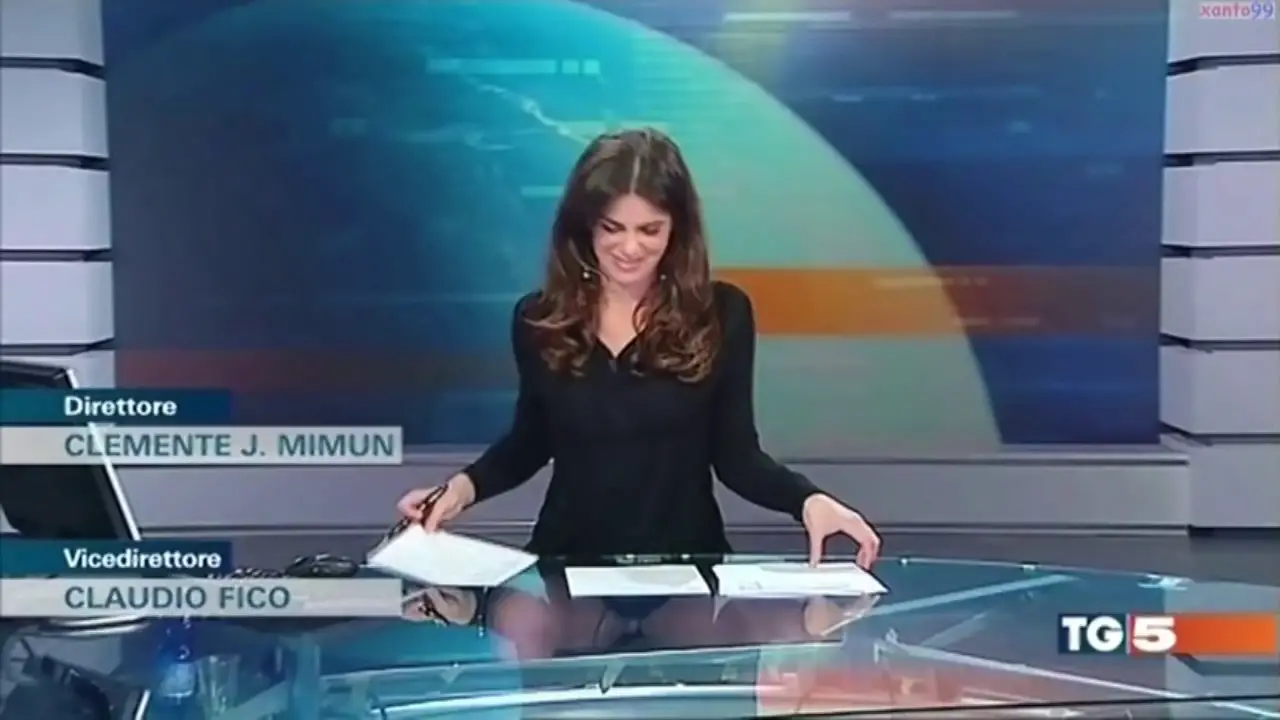Live television is an unpredictable beast, with moments of brilliance and the occasional blunder that can unexpectedly captivate millions. One such moment occurred in 2016 when respected Italian journalist Costanza Calabrese experienced an on-air mishap that quickly went viral. What began as a routine news segment turned into an internet sensation, generating waves of discussion, amusement, and even empathy from viewers across the world.

The Incident That Shocked and Amused Millions
Costanza Calabrese, a highly regarded journalist, was presenting a late-night news segment for the Italian TV channel TG5. She appeared professional and composed as she delivered the latest news updates, seated at a sleek and modern glass desk. Initially, the camera was zoomed in on her upper body and face, maintaining the usual news broadcast framing. However, as the segment progressed, the camera angle gradually shifted and zoomed out, revealing more of the studio environment.
Unbeknownst to Calabrese, the transparency of the desk made her sitting posture unexpectedly revealing. She had positioned her legs in a way that, under normal circumstances, would have been completely unremarkable. However, the glass desk provided an unintended view that instantly caught the attention of viewers.
It didn’t take long for someone to capture the moment and share it on YouTube, where it quickly gained traction. Within days, the video had amassed millions of views, with social media users buzzing about the unexpected broadcast blooper.

As the video circulated, reactions from the public varied widely. Some viewers found the incident humorous, while others expressed sympathy for Calabrese, arguing that the mishap was a failure on the part of the production team.
One concerned viewer commented, “Poor woman! Surely her producers should have let her know something was up!” This sentiment was shared by many who believed that such an oversight should have been prevented with proper angle checks and studio awareness.
Another puzzled viewer questioned, “How was her dress positioned so high in the first place?” This sparked a debate about whether journalists should be briefed on set transparency and how wardrobe choices might unintentionally contribute to similar issues.
On the lighter side, some users turned the moment into an opportunity for witty remarks. One commenter jokingly referenced journalistic ethics, stating, “When in journalism class they teach you that you have to be transparent and not hide anything. Number one.” Another quipped, “Thank you, Costanza. That’s beautiful.”
Beyond humor and criticism, the incident also ignited discussions about the professionalism and responsibility of production crews. While live TV is notorious for its unpredictability, many felt that such a glaring oversight should have been caught in pre-broadcast checks. The debate extended into broader conversations about the role of behind-the-scenes staff in ensuring seamless, professional news delivery.

Calabrese’s incident serves as a potent reminder of the immense challenges journalists face in live broadcasting. Unlike pre-recorded segments, live TV leaves no room for post-production edits or second takes. Every movement, every word, and every camera angle must be meticulously planned to avoid mishaps.
Even the most seasoned professionals are not immune to unexpected challenges. From teleprompter failures to background interruptions, journalists must adapt in real-time while maintaining composure. In Calabrese’s case, she remained completely unaware of the situation unfolding on-screen, further highlighting how crucial studio coordination is in maintaining professionalism.
Lessons Learned and the Importance of Media Training
While Calabrese was the one caught in the viral moment, the broader lesson falls on the shoulders of media professionals and production teams. Media training often emphasizes poise, articulation, and crisis management, but practical considerations such as wardrobe choices and set design also play an essential role.
Following the incident, industry experts pointed out that transparency in modern studio designs—such as glass desks—should be paired with enhanced awareness among broadcasters. Many news stations have since become more cautious in ensuring that presenters are fully aware of the studio environment and how different camera angles might present them on screen.
The Resilience of Costanza Calabrese
Despite the viral nature of the incident, Costanza Calabrese has continued her career as a respected journalist. Her professionalism and journalistic integrity remain intact, proving that even widely publicized blunders do not define a person’s capabilities or contributions to the industry.
In an era where viral moments can sometimes overshadow real achievements, Calabrese’s career trajectory reminds us that one mishap does not diminish years of hard work and dedication. The fleeting nature of internet trends means that while the moment may have gained significant attention in 2016, her reputation as a credible journalist has endured far beyond it.
Final Thoughts: The Unpredictability of Live Television
The viral mishap involving Costanza Calabrese underscores both the challenges and unpredictability of live broadcasting. While it provided lighthearted amusement for many, it also served as an important lesson in media production, highlighting the need for heightened awareness in set design, camera work, and presenter positioning.
At its core, this incident is a testament to the resilience required in the world of journalism. In an industry where the unexpected can happen at any moment, adaptability and professionalism remain key. For Costanza Calabrese, the incident was just a blip in an otherwise distinguished career—one that continues to inspire aspiring journalists worldwide.

